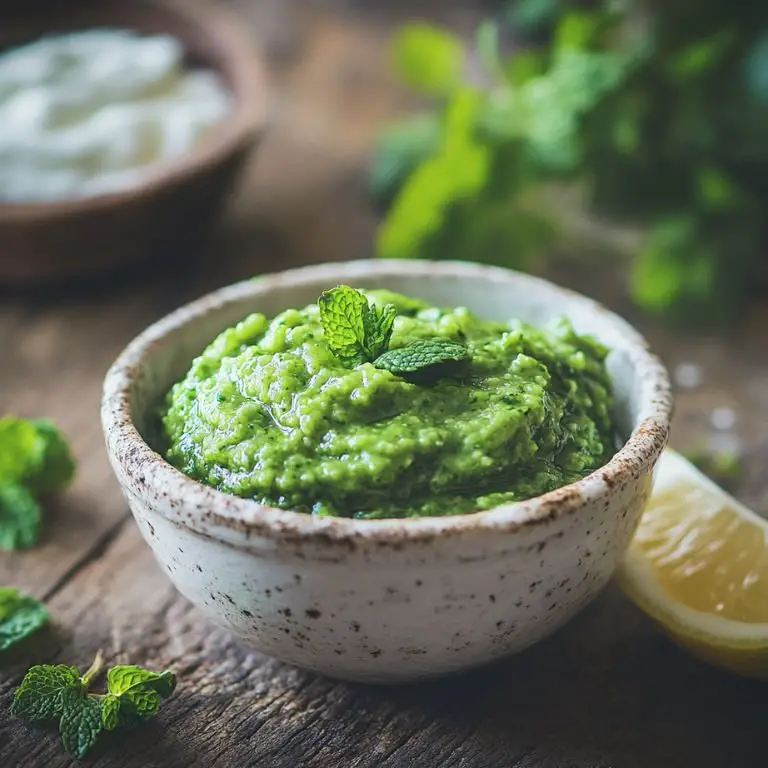
Mint chutney is a zesty and versatile condiment that brings a refreshing kick to any dish. Whether you're drizzling it over grilled meats, slathering it on sandwiches, or serving it as a dip with crispy snacks, this vibrant green sauce is a must-have in your kitchen. If you're looking for recipes with mint leaves, this one is a game-changer—fresh, tangy, and bursting with flavor!
This mint sauce recipe pairs beautifully with:
Cilantro may seem like a supporting player in mint chutney, but its role is anything but minor. While mint delivers the bold, cooling sensation this chutney is known for, cilantro brings a deeper, more rounded herbal flavor that helps balance mint’s intensity. Cilantro also adds moisture and a slightly citrusy undertone, enhancing the chutney’s complexity. Without it, the chutney can feel one-dimensional or overly sharp.
For those who dislike the taste of cilantro (often described as soapy due to genetic sensitivity), parsley can be used as a substitute. Spinach is another mild, color-rich option that adds body without overpowering the mint. However, using only mint will create a much more pungent sauce, so balancing it with another green is recommended.
The hallmark of a good mint chutney is its vibrant, refreshing quality—and that comes from a carefully balanced combination of ingredients. Fresh mint leaves are the star, offering a cool and bright aroma that instantly lifts the palate. Cilantro adds depth, while green chili introduces a burst of heat that lingers without overwhelming.
The tartness of lemon juice provides acidity that sharpens the other flavors and enhances the chutney’s green hue. A small amount of sugar can mellow any bitterness from the herbs, and cumin powder adds an earthy base note that rounds out the overall taste. Optional yogurt brings a creamy tang, softening the heat and lending a smooth texture.
The result is a symphony of fresh, spicy, tangy, and earthy flavors—perfect for cutting through rich or fried foods.
While mint chutney is a beloved staple in Indian households, its appeal stretches far beyond traditional dishes. This versatile condiment pairs beautifully with a variety of global cuisines:
Its bold flavor and vibrant color make mint chutney an excellent way to elevate ordinary dishes and experiment with cross-cultural flavors.
Mint chutney is best enjoyed fresh, but with a few smart storage tips, you can extend its life while maintaining its flavor and color.
To refresh the chutney after storage, blend it again with a splash of water or a spoonful of fresh yogurt to revive the texture and brightness.
Even a simple recipe like mint chutney can go wrong if you’re not careful. Here are a few common pitfalls to avoid:
Mind these details, and your mint chutney will stay bold and bright every time.
While the core ingredients—mint, cilantro, lemon, and chili—remain consistent, different regions in India have their own spin on this chutney. In northern India, it’s often made with yogurt for creaminess, while in southern India, coconut or roasted chana dal may be added for texture and richness. Some versions include tamarind paste or raw mango for extra tanginess, especially when citrus isn’t available.
For a South Indian twist, try adding a teaspoon of grated coconut and a few curry leaves during blending. In Gujarati cuisine, a touch of jaggery may be used instead of sugar for sweetness with depth. These variations not only change the flavor but also offer new pairings and meal ideas.
Don’t limit mint chutney to dipping—use it as a flavor enhancer throughout your meals. Swirl it into hummus for a herby upgrade, spread it on toast with mashed avocado, or mix it into salad dressings for a zesty kick. You can also use it as a marinade base for grilled tofu or fish, or stir it into yogurt to create a cooling raita.
One of the best ways to ensure a steady supply of fresh mint for chutney is to grow your own—and it’s easier than you might think.
Mint thrives in both pots and garden beds but is best contained in planters to prevent it from overtaking other plants. It prefers partial shade but can handle full sun with sufficient watering.
Start with a small cutting or seedling, and plant it in well-drained, fertile soil. Keep the soil moist but not soggy. Mint spreads quickly via underground runners, so give it room to grow or trim regularly.
To harvest, pinch the top leaves to encourage bushier growth. The best time to pick mint is in the morning when the oils are most concentrated. Rinse thoroughly before use.
If you grow more than you can use, freeze excess mint in zip-lock bags or ice cube trays with water for later use. You can also dry mint for tea or seasoning, though it won’t be ideal for chutney.
Homegrown mint ensures you always have access to the freshest, most flavorful leaves—and adds a touch of green to your kitchen or balcony.
Fresh mint leaves are essential for the bright, fresh flavor of this chutney. Dried mint lacks the same punch and should only be used in small amounts if absolutely necessary.
Adding lemon juice helps preserve the vibrant green color. Storing it in an airtight container in the fridge also slows oxidation.
Yes! While cilantro adds depth, you can increase the mint leaves to compensate or add a handful of spinach for extra freshness.
The spice level depends on the green chili used. For a milder version, remove the seeds or skip the chili altogether.